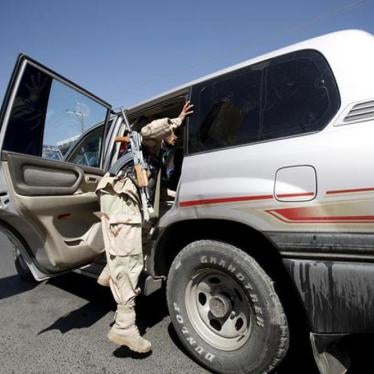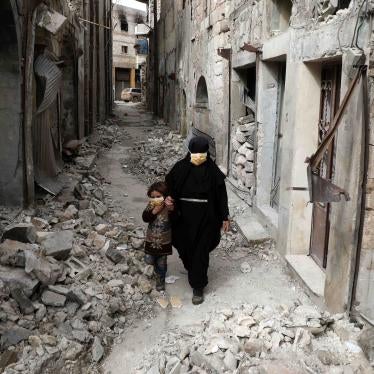(Beirut) – Houthi-Saleh forces have repeatedly fired artillery indiscriminately into populated neighborhoods of Taizz, Yemen’s third largest city, in violation of the laws of war, Human Rights Watch said today. Over a 10-day period in May 2017, shelling of the city by the Houthi armed group and forces loyal to former president Ali Abdullah Saleh resulted in the deaths of at least 30 civilians and wounded more than 160 others, according to doctors at two local hospitals. The opposing government-affiliated forces of President Abdu Rabu Mansour Hadi also appear to have fired artillery indiscriminately into populated areas outside the city.
Human Rights Watch documented seven attacks between May 21 and 23 that killed at least 12 civilians, including four children, and wounded 29, including 10 children. Houthi-Saleh forces apparently carried out six artillery attacks on Taizz city, which is controlled by forces affiliated with the Yemeni government. On May 22, government-affiliated forces appear to have shelled al-Hawban district, under Houthi-Saleh control, northeast of Taizz, and killed three civilians, including two children, and wounded two others.
“Houthi-Saleh forces’ shelling of populated areas of Taizz has taken a terrible toll on civilians,” said Sarah Leah Whitson, Middle East director at Human Rights Watch. “Houthi-Saleh commanders should immediately halt these indiscriminate attacks, and Yemeni government forces should ensure that their own forces are not launching similarly unlawful attacks outside the city.”
Human Rights Watch interviewed 14 witnesses to the May attacks along with local activists and health professionals. During the past two years, Houthi-Saleh forces, which control the capital and other areas of the country, have repeatedly fired mortar projectiles and artillery rockets from an elevated area in al-Hawban district indiscriminately into populated areas in Taizz.
Yemeni government-affiliated forces have controlled most of Taizz city since March 2016. Local monitors, including one in al-Hawban district, have reported numerous indiscriminate attacks by Houthi-Saleh forces into the city, and occasional unlawful strikes by government-affiliated forces, like the May 22 shelling, into al-Hawban. Mwatana, a leading Yemeni human rights organization, reported that Houthi-Saleh forces were responsible for most of the dozens of indiscriminate shelling incidents they documented in Taizz between April 2015 and March 2016.
A local activist, Faris al-Obidi, prepared a list of casualties from attacks over the three days in May when shelling in Taizz city was particularly heavy, after speaking with witnesses and survivors, as well as consulting logs at Taizz’s three hospitals. The list, which he shared with Human Rights Watch, included the names, ages, and date of injury for 54 civilians. Among the 14 dead were three children and two women.
Dr. Ahmad al-Dumaini, technical director at al-Thawra, Taizz city’s main hospital, said the hospital received 58 war-wounded civilians between May 20 and 26, including 20 children, plus three people who died before arrival, including a child. He said the vast majority of these casualties were from shelling. Dr. Walid al-Watiri, the laboratory chief at al-Safwa Hospital, said al-Safwa, al-Thawra, and al-Rawda hospitals received the bodies of 31 people, including six children, and another 167 wounded, including 60 children, over a 10-day period.
The renewed shelling occurred after local government-affiliated forces pushed Houthi-Saleh forces back from several locations east of the city, said a local activist, Maher al-Absi.
The areas hit on May 21 were about 800 meters from the front lines while those hit on May 22 and 23 were in the middle of the city, far from the front lines, in “very crowded civilian places,” al-Absi said. Witnesses to the six attacks in Taizz city that Human Rights Watch documented said that no government-aligned military forces were in those neighborhoods at the time of the attacks. Witnesses to the attack outside the city said no Houthi-Saleh forces were present.
Dr. al-Dumaini from al-Thawra hospital described what happened to Malik Qaid, an 8-year-old girl who lost her arm in one of the attacks on May 23:
The worst scene I saw was the child Malik. First, I felt helpless and heartbroken because we had only one surgeon in the operating room and he was busy with other cases, but at the end he finished and he operated on her. I felt sorry for this girl. How will she live with one arm? How will she adapt with the other kids while throughout her life she will be scarred by war?
Human Rights Watch has previously documented Houthi-Saleh indiscriminate shelling in Taizz. In June 2016, shelling killed at least 18 civilians and wounded 68 others over three days, hitting markets crowded with people shopping for Ramadan, according to the UN. In August 2015, three Houthi-Saleh attacks on Taizz killed at least 14 civilians, including five women and five children. In February 2017, Taizz-based activists provided Human Rights Watch a list of dozens of attacks on Taizz since March 2015 that had resulted in scores of civilian casualties.
The laws of war applicable to the armed conflict in Yemen prohibit indiscriminate attacks that strike military objectives and civilians or civilian objects without distinction. Examples include attacks that are not directed at a specific military objective or that use weapons, such as unguided rockets, that cannot be directed at a specific military objective.
The laws of war also require commanders to choose a means of attack that can be directed at military targets and will minimize incidental harm to civilians. Explosive weapons that are so inaccurate that they cannot be directed at military targets without a substantial risk of civilian harm should not be used in populated areas. Forces also must avoid locating military objectives near densely populated areas and seek to remove civilians from the vicinity of military targets.
“Commanders of Houthi-Saleh forces could face war crimes charges for ordering attacks that indiscriminately strike Taizz’s populated neighborhoods,” Whitson said. “All sides need to abide by the laws of war to minimize harm to civilians who have endured more than two years of fighting.”
May 21
On May 21, 2017 at about 5 p.m., a munition hit al-Humaira area, Sala district, a residential neighborhood about 200 meters from the front lines, killing a woman and her son and wounding four others, including the woman’s daughter.
Abdulrahman al-Naqeeb, 28, told Human Rights Watch that he and his friends heard a loud explosion and saw that a munition hit near a security checkpoint, wounding a local security officer. Fragments also struck a small van that contained a driver, and a woman and her two children. Al-Naqeeb said:
After the explosion, we heard someone calling for help. Four or five of us went to help…
I didn’t recognize them at first, the driver was wounded. When we arrived at the hospital, they told us the woman was dead already, and I was looking at her son, and I was wondering why his face was very familiar to me. I was shocked, as I realized that she is my sister-in-law, and those are her kids. They were coming to visit us.
Eman al-Sufiani, 37, a recent widow, and her son Muhanned, 13, died in the attack. Her 8-year-old daughter, Shahad, was wounded. A local activist said three other men, including one of the men who worked at the checkpoint and the driver, were wounded in the attack.
Two more attacks that day, one near a school and the other near a mosque, killed five civilians, including a child. Three others were wounded, including two children, according to local activist al-Obidi.
May 22
On May 22 at about 1:30 p.m., a munition hit near Taizz’s Great Gate in al-Qahira district, a crowded area where people regularly gather to shop at the nearby market. According to al-Obidi’s casualty list, the attack killed one civilian and wounded 10, including a child.
Hamoud al-Shar’abi, 20, was buying vegetables in the market near the Great Gate when the munition hit. He said:
The first shell hit very close to me. People fell. Some got wounded. … I was thinking of rescuing a guy close to me. I didn’t know what to do. … Then I found myself on the ground, I lost consciousness.
Al-Shar’abi’s father said he heard an explosion followed by light cannon firing: “We got scared. The people were running away. Someone came and told us he saw someone with a motorbike rescue my son. I was terrified for my kid.”
Doctors performed surgery twice on al-Shar’abi and removed a light cannon round from his body. He provided Human Rights Watch a photo of the removed round.
Another attack that day on the al-Askari neighborhood wounded three civilians, including a 50-year-old woman and a 17-year-old boy, al-Obidi said.
The same day, government-affiliated forces appear to have shelled indiscriminately into al-Hawban district, northeast of Taizz. According to a local activist, the attack occurred at about 5:10 a.m., hitting al-Jumla neighborhood. A neighborhood resident, 25, said he was waiting for a grocery store to open after the morning prayers when the shell hit: “The loudness of the attack brought all the people from the neighborhood to rescue us.” He was wounded, as was a 16-year-old boy standing near him. Three people, including a 15-year-old and 17-year-old boy, were killed.
May 23
On May 23 at about 11:30 a.m., a munition hit a fruit cart near Mousa Gate in al-Qahira district, wounding five civilians, including three children, according to al-Obidi. Hani Saeed, a 35-year-old owner of a nearby barbershop, said that he rushed to help a 16-year-old girl who sells vegetables next to his shop and her aunt, who were both wounded.
At about 4:30 p.m., at least three munitions hit al-Daboua’a neighborhood, about 10 to 15 minutes apart, killing at least five civilians, including one child, and wounding seven, including four children.
In a video made immediately after the attack, an impact crater and fragmentation pattern on the asphalt indicate a 120mm mortar projectile was used. Based on the direction of the impact, the projectile was fired in an east-to-west direction, which fits with a mortar fired from the locations to the east of the city where Houthi-Saleh forces are known to be positioned.
Haza’a Nubish, a local resident, said the first al-Daboua’a munition hit near the Motherhood and Childhood Center, a small health center, killing his cousin Salem Kudaf and wounding Kudaf’s 5-year-old son, Sami. Fragments from the munition also wounded a 13-year-old girl.
The next two munitions struck near a construction materials store, one hitting a house and the other the middle of the street, killing four people, including a 7-year-old boy, and wounding three, including a 12-year-old boy, Nubish said.
Ghazal Qassim, 24, said she was in a shop with her two sons, one an infant, when the munitions struck. She said she was terrified and sought cover. She went to the hospital after the attack, as she had metal fragments in her back, and her 4-year-old son’s hand was wounded.
At about the same time as the attacks on al-Daboua’a, Flah al-Atfi, 32, was killed and Ameen al-A’shari, 54, lost both his legs after a munition hit about 500 meters east of the Central Security Forces headquarters in Taizz, said al-A’shari’s son.










